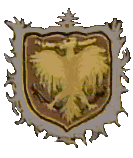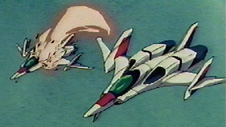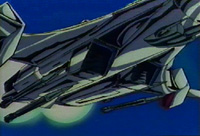

Designation:F-207 Sylphid (A,B,T) Fighter |

|
||||

|
|||||
| Total Length: | 12.8 m |
| Total Height: | 4.9 m |
| Total Wingspan: | 12.2 m |
| Total Dry Weight: | 11.8 metric tons |
While the electronics suites of these vehicles differed with their respective dates of operational service, all electronics were regularly updated, and during the Second Robotech War the following standard was in use:

4 hardpoints are mounted on the lower hull. Each hardpoint can typically carry:
Typical Payloads:
The skin of the Sylphid is composed of an advanced titanium-steel alloy. The skin stops all small arms fire, provides fair protection against heavier infantry weapons, such as a 12.7mm machinegun round, and poor resistance to light mecha-mounted weaponry, such as the Zentraedi 22.3mm HE autocannon round. The Sylphid provides full protection from nuclear, biological, and chemical hazards, using an overpressure cockpit environment activated by radiation and hazardous chemical sensors, or manually when biological warfare conditions are anticipated. The internal consumables supplies can provide atmosphere for one day maximum.
The Sylphid was the primary tactical airborne mecha of the Southern Cross' Tactical Air Force. Developed under the same government drive to limit the defense spending by producing non-transformable planes rather than Veritechs wherever they was not clearly needed, the Sylphid was a pure jet aircraft.

Developed in 2018-2020, the Sylphid was a typical Robotech Fighter of that area, with two engines blocks mounted alongside an armored hull. Missiles or missile pods could be attached to four fixed hardpoints on the lower hull, and two energy cannons were located near the nose, next to the cockpit. The engines were fusion turbine designs, to increase the tactical flexibility by doing away with range restrictions, and also enabling the plane to be effective at very high altitudes. This also increased the thrust, and with the highly capable Southern Cross electronics package, the Sylphid was also competent as a ground assault aircraft, though it never fully replaced the Executioner in that role. The end result was a plane that was almost the equal of the Valkyrie and the Lightning, save for sustained airspeeds.
The Sylphid entered service with the Tactical Air Force in 2021, and remained in service with this unit until the Invid invasion. In 2029, a new engine was installed, and the new variant built around it, the F-207B, immediately began to replace its predecessor, though the conversion was not completed before the Invid arrived. The two variants can be distinguished by the fact that the FF-3001 fit had three sub-nozzles per engine, and the FF-3031 had four.
This plane was shown to be less than successful against the Robotech Masters, partly because its bases kept getting shot up, but mainly because as a fighter it was completely overclassed by the Assault Carrier, against which it could not mount heavy enough weapons to be fully effective. Against the Invid, the Sylphid was only effective during the initial invasion. After the ground bases were overrun, the Sylphid was effectively obsolete, for its non-VTOL design made the plane useless for resistance fighters.
Return to Southern Cross aircraft Index.
Go to Robotech Reference Guide Home Page.
Robotech (R) is the property of Harmony Gold. This document is in no way intended to infringe upon their rights.
Content by Pieter Thomassen and Peter Walker